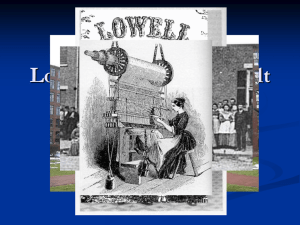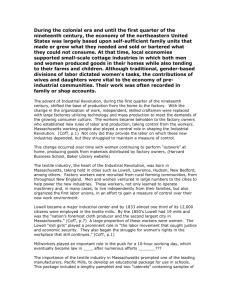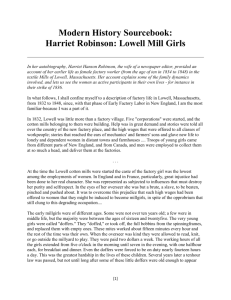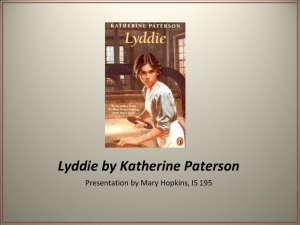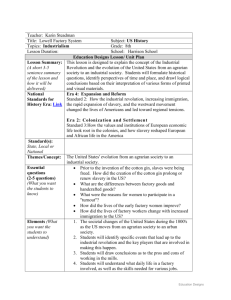Chapter 7 - San Ramon Valley High School
advertisement
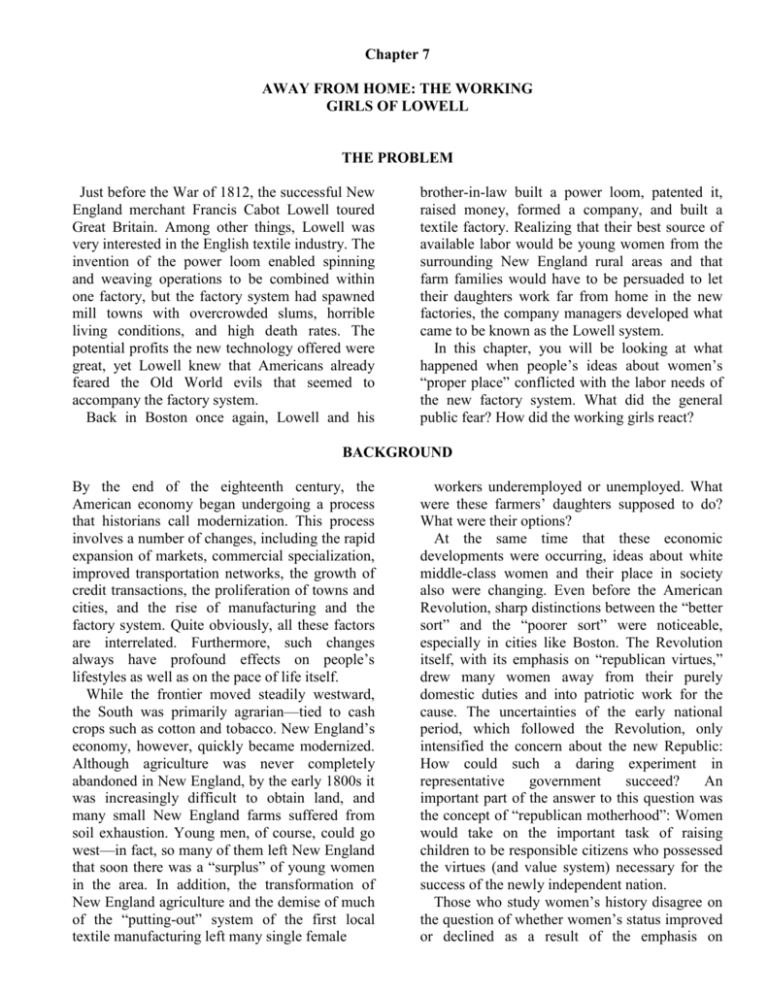
Chapter 7 AWAY FROM HOME: THE WORKING GIRLS OF LOWELL THE PROBLEM Just before the War of 1812, the successful New England merchant Francis Cabot Lowell toured Great Britain. Among other things, Lowell was very interested in the English textile industry. The invention of the power loom enabled spinning and weaving operations to be combined within one factory, but the factory system had spawned mill towns with overcrowded slums, horrible living conditions, and high death rates. The potential profits the new technology offered were great, yet Lowell knew that Americans already feared the Old World evils that seemed to accompany the factory system. Back in Boston once again, Lowell and his brother-in-law built a power loom, patented it, raised money, formed a company, and built a textile factory. Realizing that their best source of available labor would be young women from the surrounding New England rural areas and that farm families would have to be persuaded to let their daughters work far from home in the new factories, the company managers developed what came to be known as the Lowell system. In this chapter, you will be looking at what happened when people’s ideas about women’s “proper place” conflicted with the labor needs of the new factory system. What did the general public fear? How did the working girls react? BACKGROUND By the end of the eighteenth century, the American economy began undergoing a process that historians call modernization. This process involves a number of changes, including the rapid expansion of markets, commercial specialization, improved transportation networks, the growth of credit transactions, the proliferation of towns and cities, and the rise of manufacturing and the factory system. Quite obviously, all these factors are interrelated. Furthermore, such changes always have profound effects on people’s lifestyles as well as on the pace of life itself. While the frontier moved steadily westward, the South was primarily agrarian—tied to cash crops such as cotton and tobacco. New England’s economy, however, quickly became modernized. Although agriculture was never completely abandoned in New England, by the early 1800s it was increasingly difficult to obtain land, and many small New England farms suffered from soil exhaustion. Young men, of course, could go west—in fact, so many of them left New England that soon there was a “surplus” of young women in the area. In addition, the transformation of New England agriculture and the demise of much of the “putting-out” system of the first local textile manufacturing left many single female workers underemployed or unemployed. What were these farmers’ daughters supposed to do? What were their options? At the same time that these economic developments were occurring, ideas about white middle-class women and their place in society also were changing. Even before the American Revolution, sharp distinctions between the “better sort” and the “poorer sort” were noticeable, especially in cities like Boston. The Revolution itself, with its emphasis on “republican virtues,” drew many women away from their purely domestic duties and into patriotic work for the cause. The uncertainties of the early national period, which followed the Revolution, only intensified the concern about the new Republic: How could such a daring experiment in representative government succeed? An important part of the answer to this question was the concept of “republican motherhood”: Women would take on the important task of raising children to be responsible citizens who possessed the virtues (and value system) necessary for the success of the newly independent nation. Those who study women’s history disagree on the question of whether women’s status improved or declined as a result of the emphasis on republican motherhood. Nevertheless, it was clear that the new focus on motherhood and child rearing would not only reduce the variety of roles women could play but also limit women’s proper place to their own homes. As historian Alice Kessler-Harris notes in her study of wage-earning women in the United States, there was a direct conflict for poorer or unmarried women between their need to earn money and the ideology that home and family should be central to all women’s lives.1 This emphasis on domestic ideology, Kessler-Harris concludes, sharpened class divisions and eroded any possibility of real independence for women. Historian Christine Stansell reaches many of the same conclusions in her study of gender and class in New York City.2 In addition, according to Stansell, young unmarried working women often dressed and behaved in ways that directly challenged domestic ideology and women’s place within the home. Such alternative ways of living, especially on the part of young, white, nativeborn, Protestant women, were deeply disturbing to many Americans, both male and female. In periods of rapid change, people often try to cling to absolute beliefs and even create stereotypes that implicitly punish those who do not conform. Such a stereotype began to emerge after the American Revolution. According to this stereotype, every “true” woman was a “lady” who behaved in certain ways because of her female nature. Historian Barbara Welter has called this phenomenon the “cult of true womanhood.”3 True women possessed four virtues: piety, purity, submissiveness, and domesticity. These characteristics, it was thought, were not so much learned as they were biologically natural, simply an inherent part of being born female. Women’s magazines, etiquette books for young ladies, sermons and religious tracts, and popular short stories and novels all told women what they were like and how they should feel about themselves. Such sources are called “prescriptive literature” because they literally prescribe how people should—and should not—behave. Alice Kessler-Harris, Out to Work. A History of America’s Wage-Earning Women (New York: Oxford, 1982). 2 Christine Stansell, City of Women: Sex and Class in New York, 1789—1860 (New York: Knopf, 1986). 3 Barbara Welter, “The Cult of True Womanhood, 18201860,” American Quarterly 18 (Summer 1966): 151-174. 1 What, then, was expected of New England farmers’ daughters and other respectable (white) women? They were supposed to be more naturally religious than men (real men might occasionally swear, but real women never did). Because they were naturally logical and rational, men might pursue education, but true women should not because they might be led into error if they strayed from the Bible. As daughters, wives, or even sisters, women had the important responsibility of being the spiritual up-lifters to whom men could turn when necessary. Just as important as piety was the true woman’s purity. This purity was absolute because whereas a man might “sow his wild oats” and then be saved by the love of a good woman, a “fallen woman” could never be saved. In the popular fiction of the period, a woman who had been seduced usually became insane, died, or did both. If she had a baby, it also came to a bad end. Only on her wedding night did a true woman surrender her virginity, and then out of duty rather than passion, because it was widely believed that pure women were not sexually responsive. In fact, many young women of this era knew nothing at all about their own bodies or the nature of sexual intercourse until they married. Submission and domesticity were perhaps not as vital as piety and purity. Although women who did not submit to men’s leadership were destined to be unhappy (according to the thought of the day), they could correct their mistaken behavior. Men were, after all, stronger and more intelligent, the natural protectors of women. A true woman, wrote then-popular author Grace Greenwood, should be like a “perpetual child,” who is always “timid, doubtful, and clingingly dependent.” Such pious, pure, submissive women were particularly well suited to the important task of creating a pleasant, cheerful home—a place where men could escape from their worldly struggles and be fed, clothed, comforted, and nursed if they were ill. Even a woman who did not have very much money could create such a haven, people believed, simply by using her natural talents of sewing, cooking, cleaning, and flower arranging. Simultaneously, then, two important trends were occurring in the early 1800s: the northern economy was modernizing, and sexual stereotypes that assigned very different roles to men and women were developing. Whereas a man should be out in the world of education, work, and politics, a woman’s place was in the home, a sphere where she could be sheltered. But what would happen if the economic need for an increased supply of labor clashed with the new ideas about women’s place in society? If a young unmarried woman went to work in a factory far away from her parents’ farm, would she still be respectable? Where would she live? Who would protect her? Perhaps the experience of factory work itself would destroy those special feminine characteristics all true women possessed. All these fears and more would have to be confronted in the course of the development of the New England textile industry during the 1830s and 1840s. Although the first American textile mill using water-powered spinning machines was built in 1790, it and the countless other mills that sprang up throughout New England during the next thirty years depended heavily on the putting-out system. The mills made only the yarn, which was then distributed (“put out”) to women who wove the cloth in their own homes and returned the finished products to the mills. In 1820, two-thirds of all American cloth was still being produced by women working at home. But the pace of modernization accelerated sharply with the formation of the Boston Manufacturing Company, a heavily capitalized firm that purchased a large tract of rural land in the Merrimack River valley. The Boston Associates adopted the latest technology and, more important, concentrated all aspects of cloth production inside their factories. Because they no longer put out work, they had to attract large numbers of workers, especially young women from New England farms, to their mills. Lowell, Massachusetts (the “City of Spindles”), and the Lowell mills became a kind of model, an experiment that received a good deal of attention in both Europe and America. As historian Thomas Dublin has shown, most of the young women at the Lowell mills were fifteen to thirty years old, unmarried, and from farm families that were neither the richest nor the poorest in their area. Although some of the Lowell girls occasionally sent small amounts of money back to their families, most used their wages for new clothes, education, and dowries.4 These wages 4 A dowry is the money, goods, or property that a woman brings into her marriage. were significantly higher than those for teaching, farm labor, or domestic services, the three other major occupations open to women. The factory girls were required to live and eat in boardinghouses run according to company rules and supervised by respectable landladies. The company partially subsidized the cost of room and board and also encouraged the numerous lecture series, eve-fling schools, and church-related activities in Lowell. Girls worked together in the mills, filling the unskilled and semiskilled positions, and men (about one-fourth of the work force) performed the skilled jobs and served as overseers (foremen). Work in the mills also was characterized by strict regulations and an elaborate system of bells that signaled meal-times and work times. During the 1840s, factory girls occasionally published their own magazines, the most famous of which was the Lowell Offering. This journal grew out of a working woman’s selfimprovement society and was sponsored by a local Lowell minister. When the minister was transferred, the mill owners partially subsidized the magazine. The female editors, who were former mill workers, insisted that the magazine was for “literary” work rather than for labor reform. The Evidence section presents a description of Lowell mills and boardinghouses and several selections from the Lowell Offering and other sources. The conflict between economic modernization and the cult of true womanhood was indirectly recognized by many New Englanders and directly experienced by the Lowell mill girls. What forms did this conflict take? What fears and anxieties did it reveal? How did the mill girls attempt to cope with this tension. [QUESTIONS 1. A) What is meant by “modernization?” B) How did this process create a split between North and South? 2. A) What is meant by “republican motherhood?” B) How did it affect women’s lives? C) How did it deepen class divisions? 3. A) What is the “cult of true womanhood?” B) What were the four characteristics necessary for “true womanhood” and how did it create a double standard (one set of ideals for men, a separate set of ideals for women)? 4.What was the “putting-out system” and how was it transformed by the Market Revolution? 5. What were the characteristics of the average Lowell Girl and what was her life like in Lowell?]
